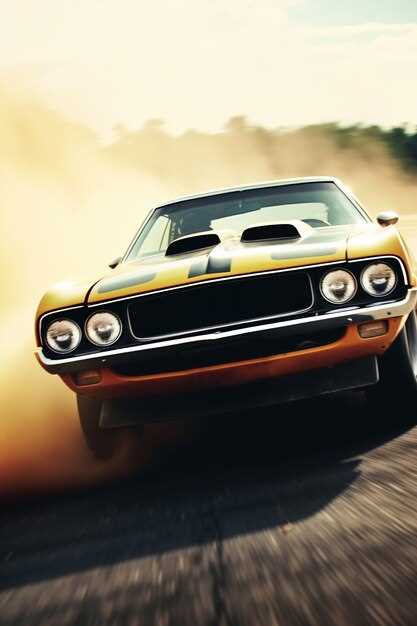American muscle cars have shaped automotive culture since their inception, becoming symbols of power and performance. Each decade brought distinct styles and innovations that captured the spirit of the times. Understanding these changes reveals how these vehicles continue to resonate with enthusiasts and collectors alike.
In the 1960s, manufacturers like Ford, Chevy, and Dodge introduced iconic models that defined the muscle car era. The Ford Mustang and Chevrolet Camaro emerged, featuring powerful V8 engines and sleek designs that appealed to a generation craving speed and style. These cars not only pushed boundaries in terms of speed but also fueled a competitive market that emphasized horsepower and aesthetics.
The 1970s saw a shift, as muscle cars adapted to stricter emissions regulations and rising fuel prices. Despite these challenges, vehicles like the Pontiac Trans Am and the Dodge Challenger maintained their allure. Innovations in engine technology and a focus on weight reduction allowed manufacturers to keep performance alive while addressing environmental concerns.
Fast forward to the 1980s and 1990s, the market experienced a decline in traditional muscle cars. However, this period didn’t signal the end. Instead, it paved the way for modern interpretations, with manufacturers revisiting classic designs and concepts. The revival of models like the Chevrolet Camaro in the early 2000s highlighted the enduring popularity of muscle cars, blending classic styling with contemporary performance standards.
Today, muscle cars continue to thrive, incorporating cutting-edge technology while preserving the raw power that enthusiasts cherish. With brands like Ford and Chevy pushing out modern iterations of their legendary models, the legacy of American muscle cars remains robust. Exploring this evolution not only provides insight into automotive history but also showcases the unwavering passion for performance vehicles.
Tracking Performance Enhancements from the 1960s to Today
Focus on the horsepower battle that ignited in the 1960s, where manufacturers like Ford and Chevrolet pushed their engines to produce over 400 horsepower, setting the stage for muscle car performance. Innovations such as the introduction of unibody construction and high-performance components like dual exhaust systems allowed for lighter designs and improved airflow, directly impacting speed and efficiency.
Shift to the 1970s, and tightening emissions regulations forced a rethink of performance. Automakers began focusing on fuel efficiency while attempting to maintain power. Technologies such as catalytic converters became standard. However, some muscle cars, like the Pontiac Trans Am, managed to squeeze out impressive power levels by optimizing engine tuning and weight reduction techniques.
In the 1980s, turbocharging emerged as a powerful tool. Cars like the Buick Grand National showcased how forced induction could elevate performance despite lower displacement engines. The era also saw a rise in digital ignition systems, which improved timing accuracy and engine response, further enhancing overall performance.
The 1990s heralded the return of the big block with vehicles like the Dodge Viper and Chevrolet Corvette. Advances in materials and engineering allowed for lighter, stronger components, improving acceleration and handling. The addition of advanced safety features and improved suspension systems struck a balance between power and drivability.
In the 2000s, technology took a leap forward. Vehicles equipped with superchargers and more sophisticated engine management systems achieved unprecedented horsepower. The Ford Mustang Shelby GT500, for instance, boasted over 500 horsepower, showcasing how modern engineering techniques can yield powerful results while meeting stricter environmental standards.
Today, hybrid and electric powertrains redefine performance. The Ford Mustang Mach-E and Tesla Model S demonstrate how electric motors deliver instant torque, resulting in exhilarating acceleration from a standstill. Innovations such as regenerative braking and smart energy management not only enhance efficiency but also foster performance-friendly designs.
Monitor these advancements closely, as they shape the future of muscle cars. Engine enhancements, aerodynamic improvements, and cutting-edge technology continue to push boundaries, ensuring that American muscle stays robust and thrilling on the roads ahead.
Identifying Key Models That Defined Each Decade
The American muscle car scene has thrived through distinctive eras, each marked by iconic models that left a significant impact. Here’s a look at the standout muscle cars from each decade.
1960s:
The Ford Mustang debuted in 1964, setting the stage for the pony car movement. Not far behind, the Chevrolet Camaro emerged in 1966, igniting the rivalry that defined the decade. The Pontiac GTO, introduced in 1964, cemented its status as the first true muscle car with its powerful V8 engine.
1970s:
The Dodge Challenger, launched in 1970, showcased bold styling and formidable performance. The Chevrolet Chevelle SS 454 gained fame for its impressive horsepower, specifically the LS6 variant. This decade also saw the arrival of the Pontiac Firebird Trans Am, which became a symbol of speed and style.
1980s:
While the muscle car market began to decline, the Chevrolet Camaro IROC-Z emerged as a performance icon. The Ford Mustang GT, with its turbocharged engines, managed to keep the spirit alive. The Pontiac Fiero attempted to blend sports car traits with muscle performance, offering a fresh take during the decade.
1990s:
The Dodge Viper roared onto the scene in 1992, pairing aggressive design with a monstrous V10 engine. The Chevrolet Corvette C5 was redefined, elevating both performance and amenities. Additionally, the Ford Mustang SVT Cobra captured the essence of 90s muscle with its enhanced power and style.
2000s:
The Ford Mustang saw a major redesign in 2005 that resonated with classic enthusiasts. The Dodge Charger returned, with muscle car performance suitable for modern drivers. The Chevrolet Camaro also made its comeback in 2009, revitalizing interest with a retro-inspired design and modern capability.
2010s:
The Ford Mustang GT350, featuring advanced technology and track-ready capability, became a standout. The Chevrolet Camaro ZL1 represented a new benchmark in muscle car performance. Meanwhile, the Dodge Challenger continued to evolve with powerful variants like the Hellcat, pushing boundaries on the track.
2020s:
The electric era is beginning with the Ford Mustang Mach-E aligning muscle with sustainability. The Dodge Charger and Challenger are still thrilling enthusiasts, especially with the reveal of the new Hellcat Redeye. Chevrolet continues to innovate with the Camaro, focusing on performance and technology for a new generation.
Each muscle car from these decades showcases an evolution in design, performance, and technology, painting a picture of American automotive passion and creativity.
Understanding the Impact of Legislation on Muscle Car Development
Legislation directly shapes muscle car design and performance. The 1970s Dual Exhaust Emission Standards and the introduction of the Clean Air Act forced manufacturers to rethink engine specifications. Automakers transitioned from powerful V8 engines to smaller, fuel-efficient alternatives. This marked a decline in muscle car popularity.
The Corporate Average Fuel Economy (CAFE) standards in the late 1970s further influenced production. Companies focused on building lighter, more economical vehicles to meet these regulations. The shift led to the sometimes maligned “malaise era,” where performance took a backseat to compliance.
In the 1980s, the introduction of the Energy Policy and Conservation Act encouraged manufacturers to innovate, leading to the development of the first turbocharged muscle cars. Models like the Buick GNX showcased how power and efficiency could coexist, reviving interest in the segment.
The 1990s and early 2000s saw a resurgence with the repeal of some stringent regulations, allowing for enhanced horsepower and innovations in technology. Cars like the Ford Mustang SVT Cobra and Chevrolet Camaro Z28 redefined muscle cars, balancing power with safety and environmental standards.
Modern regulations continue to influence muscle car development through emissions limitations and safety standards. Manufacturers are now integrating electric technology to meet future standards while maintaining performance. The Dodge Charger’s hybrid models exemplify this transition, offering power without compromising ecological responsibility.
Keep an eye on upcoming legislation, as it will shape the next generation of muscle cars. Understanding these regulations provides insight into future designs and innovations, ensuring that muscle car enthusiasts remain in tune with the evolving market. Regularly checking updates from the Environmental Protection Agency (EPA) and the National Highway Traffic Safety Administration (NHTSA) can aid enthusiasts and potential buyers in recognizing trends and changes in the industry.
Examining Trends in Design and Aesthetics Over Time
Focus on the boldness of American muscle car design, which has transformed remarkably since the 1960s. Each decade showcases distinct aesthetics shaped by cultural influences, technological advancements, and consumer preferences.
In the 1960s, muscle cars flaunted aggressive lines, emphasizing speed and power. Prominent models like the Ford Mustang and Chevrolet Camaro adopted long hoods and short decks, conveying a sense of motion even at rest. Bright colors and racing stripes became common, appealing to younger drivers eager to stand out.
- 1960s: Long hoods, short decks, vibrant colors, and chrome accents.
The 1970s shifted focus toward a more refined and, at times, bulky design. Environmental regulations influenced manufacturers to adapt. Muscle cars became heavier, presenting a more robust silhouette, with luxury features creeping in. Styles reflected social changes, with safety becoming a priority, as seen in the addition of larger bumpers and restrained aesthetics.
- 1970s: Heavier builds, emphasis on safety, introduction of luxury features.
The 1980s marked a departure from traditional muscle car design, with a lean towards compact models and streamlined profiles. Performance remained critical, but the aesthetic trends shifted to more angular shapes, inspired by aerodynamics. The introduction of turbocharged engines presented a new take on power.
- 1980s: Compact and angular designs, aerodynamics prioritized, turbocharged engines.
In the 1990s, muscle cars faced further evolution, influenced by a growing interest in import tuning. The designs became sleeker but retained classic elements. Iconic models like the Dodge Viper emerged, merging performance with modern aesthetics, featuring rounded edges and a streamlined appearance.
- 1990s: Sleeker aesthetics, rounded edges, emergence of modern icons like the Dodge Viper.
Entering the 2000s and beyond, manufacturers began revitalizing classic designs while integrating modern technologies. The revival of muscle cars like the Ford Mustang and Chevrolet Camaro included updated performance features, retro styling cues, and advanced materials. These cars now combine nostalgia with innovation, merging past inspirations with futuristic technology.
- 2000s: Revivals of classic designs, modern technologies, retro styling incorporated.
Current trends highlight sustainability, with many manufacturers exploring hybrid and electric technologies, while maintaining the signature muscular styling. The increased demand for personalization allows for unique customization options, enhancing the driver’s connection to their vehicle.
- 2020s: Focus on sustainability, hybrid/electric models, personalized designs.
Understanding these aesthetic trends across decades reveals more than just shifts in style; they capture the essence of American culture, technology, and societal values. American muscle cars remain an enduring symbol of freedom and individuality, continually adapting to the time while honoring their roots.
Exploring Technological Advancements in Engine Power and Efficiency
The introduction of fuel injection systems in the late 20th century significantly improved engine performance. These systems replaced carburetors, offering precise fuel delivery and enhancing combustion efficiency. The shift led to increased horsepower while decreasing fuel consumption, allowing muscle cars to maintain power without compromising economy.
Turbocharging emerged as another key innovation, allowing smaller displacement engines to generate greater power outputs. Through forced induction, turbochargers compress air entering the engine, enabling it to burn more fuel and generate additional power. Many modern muscle cars utilize turbocharged V6 engines to achieve impressive performance metrics while maintaining better fuel economy than their V8 counterparts.
Incorporating advanced materials like aluminum and carbon fiber further boosts performance. Lighter components reduce overall vehicle weight, enhancing speed and handling. Automotive manufacturers increasingly adopt these materials, leading to improved acceleration and a more enjoyable driving experience.
The development of hybrid technology in muscle cars marks a notable shift. Combining traditional combustion engines with electric motors allows for enhanced power and torque. This setup not only meets environmental regulations but also provides instant torque delivery from electric motors, increasing responsiveness during acceleration.
Modern muscle cars also feature sophisticated engine management systems. These systems monitor various parameters, optimizing power delivery and efficiency based on driving conditions. This technology maximizes performance while ensuring engines operate within safe parameters, extending their lifespan.
As we look to the future, advances in battery technology will likely influence muscle car design. Lightweight, high-capacity batteries can enable electric muscle cars to achieve remarkable power levels and quick charging times. Manufacturers are already experimenting with fully electric powertrains, promising exhilarating performance without the confines of traditional fuel sources.
Assessing the Cultural Influence of Muscle Cars in American Society
Muscle cars symbolize more than mere horsepower; they embody freedom, rebellion, and the thrill of the open road. These vehicles have integrated themselves into the fabric of American culture, impacting music, film, and fashion. By examining their influence, we recognize their role in shaping identities and communities.
In the 1960s, muscle cars became icons of youth culture, represented in films like “American Graffiti” and songs such as “Little Deuce Coupe” by The Beach Boys. This connection between muscle cars and youthful exuberance sparked a cultural phenomenon that celebrated car ownership as an expression of individuality. Events like the Woodward Dream Cruise in Michigan pay homage to this legacy, showcasing classic muscle cars and fostering community pride.
Brands like Ford and Chevrolet leveraged this cultural significance, creating advertising campaigns that resonated with the aspirations of consumers. Car ads emphasized performance and style, appealing to a generation eager to distance itself from conformity. As a result, the sales of muscle cars soared during this era, solidifying their status as symbols of American culture.
| Decade | Notable Models | Cultural Impact |
|---|---|---|
| 1960s | Ford Mustang, Chevrolet Camaro | Representation of youth and rebellion in media |
| 1970s | Plymouth Barracuda, Dodge Challenger | Connection to muscle car racing culture |
| 1980s | Pontiac Firebird, Chevrolet Corvette | Shift towards performance-focused marketing |
| 2000s | Dodge Charger, Ford Mustang | Revival of classic designs; nostalgia marketing |
In contemporary society, muscle cars continue to influence automotive trends. They inspire modifications and customizations that reflect personal style. The rise of online communities encourages enthusiasts to share their passion, expanding the reach and relevance of muscle cars across generations. This camaraderie fosters a sense of belonging, further enhancing their cultural significance.
Music, especially rock and roll, maintains a strong correlation with muscle cars. Artists frequently reference these vehicles in their lyrics, creating a sonic connection that perpetuates their status as symbols of rebellion and freedom. This relationship illustrates how muscle cars serve as a backdrop for personal narratives and cultural storytelling.
Understanding the cultural influence of muscle cars reveals their lasting impact on American society. From shaping youth culture to fostering community, these vehicles manifest an enduring connection between people, their passions, and the open road.







